1993 CHEVROLET SUBURBAN towing
[x] Cancel search: towingPage 132 of 386
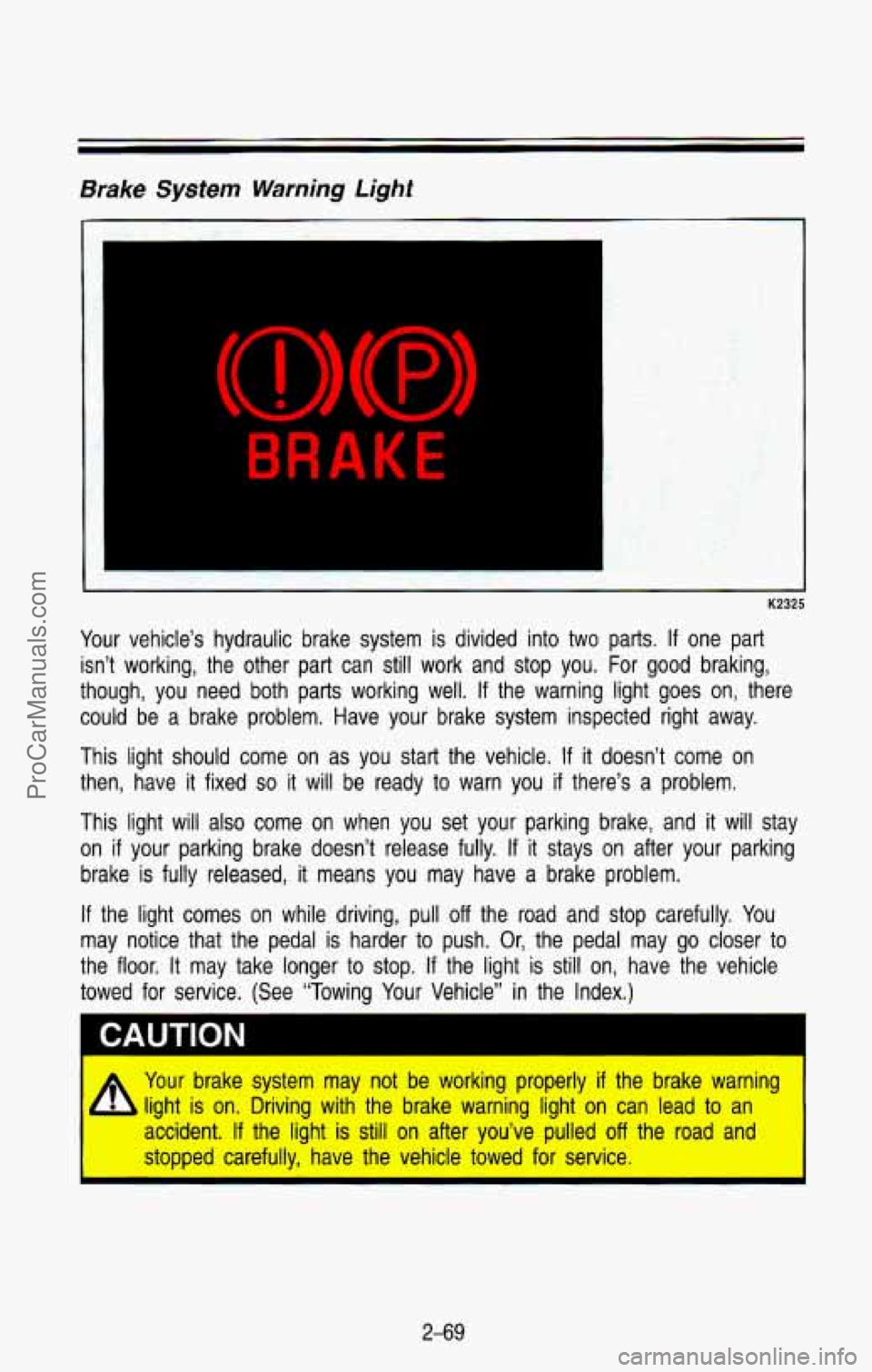
Brake System Warning Light
BRAKE
-
K2325
Your vehicle’s hydraulic brake system is divided into two parts. If one part
isn’t working, the other part can still work and stop you. For good braking,
though, you need both parts working well.
If the warning light goes on, there
could be
a brake problem. Have your brake system inspected right away.
This light should come on as you start the vehicle.
If it doesn’t come on
then, have it fixed
so it will be ready to warn you if there’s a problem.
This light will also come
on when you set your parking brake, and it will stay
on
if your parking brake doesn’t release fully. If it stays on after your parking
brake is fully released, it means you may have
a brake problem.
If the light comes on while driving, pull off the road and stop carefully. You
may notice that the pedal is harder to push. Or, the pedal may
go closer to
the floor. It may take longer
to stop. If the light is still on, have the vehicle
towed for service. (See “Towing Your Vehicle” in the Index.)
I CAUTION
I A Your brake system may not be working properly if the brake warning
b light is on. Driving with the brake warning light on can lead to an
I accident. If the light is still on after you’ve pulled off the road and
stopped carefully,
have the vehicle towed for service. I
2-69
ProCarManuals.com
Page 168 of 386
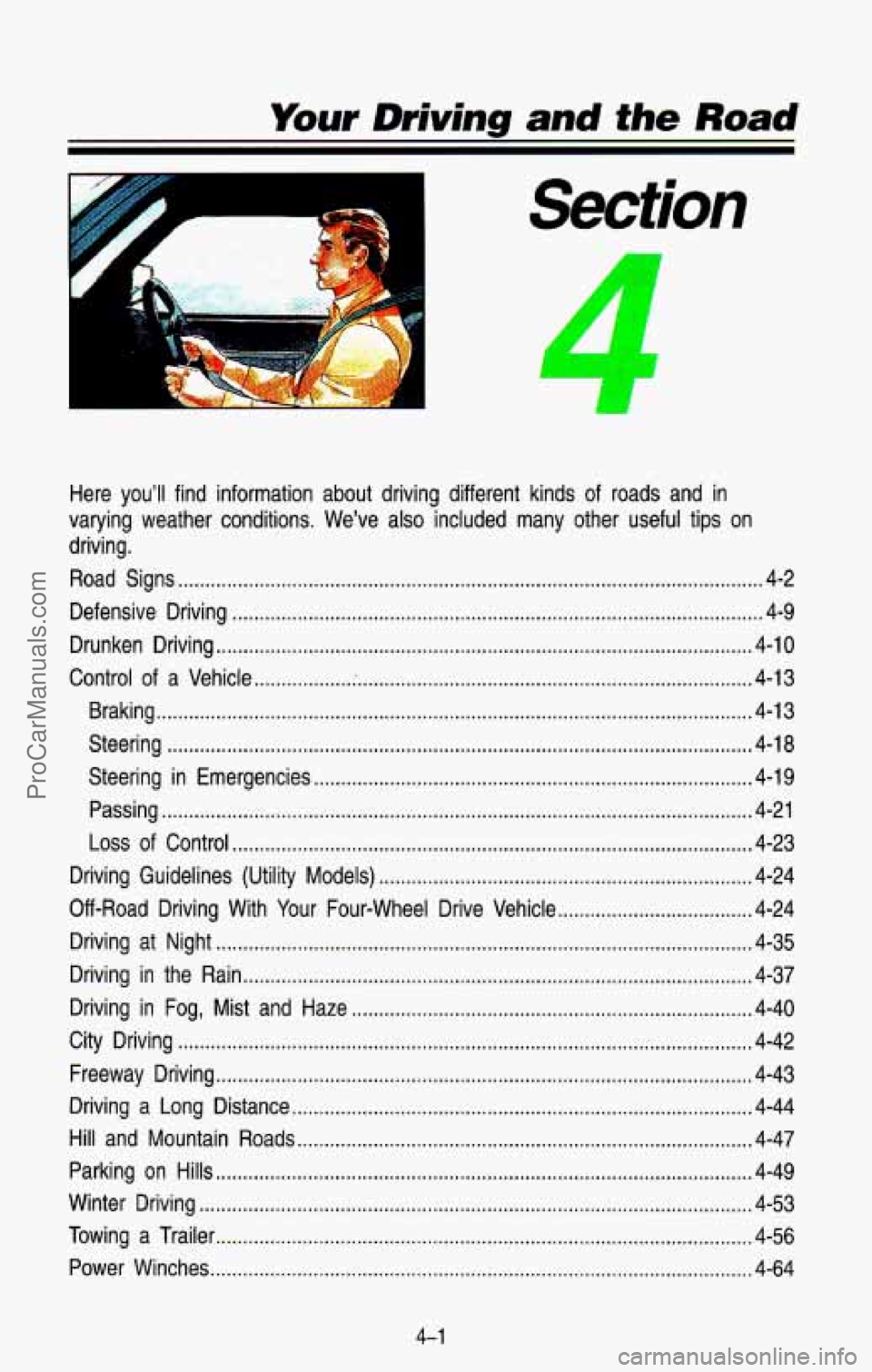
Your Driving and the Road
Here you’ll find information about driving different kinds of roads and in
varying weather conditions . We’ve also included many other useful tips on
driving
.
Road Signs ........................................................................\
.................................... 4-2
Defensive Driving
........................................................................\
.......................... 4-9
Drunken Driving
........................................................................\
........................... 4-10
Control of a Vehicle
.................. ; ........................................................................\
. 4-13
Braking
........................................................................\
...................................... 4-13
Steering
........................................................................\
.................................... 4-18
Steering in Emergencies
........................................................................\
......... 4-19
Passing
........................................................................\
..................................... 4-21
Loss of Control ........................................................................\
........................ 4-23
Driving Guidelines (Utility
Models) ..................................................................... 4-24
Off-Road Driving With Your Four-wheel Drive Vehicle
.................................... 4-24
Driving at Night
........................................................................\
........................... 4-35
Driving in the Rain
........................................................................\
...................... 4-37
Driving in Fog, Mist and Haze
........................................................................\
.. 4-40
City Driving
........................................................................\
.................................. 4-42
Freeway Driving
........................................................................\
........................... 4-43
Driving
a Long Distance ........................................................................\
............. 4-44
Hill and Mountain Roads ........................................................................\
............ 4-47
Parking
on Hills ........................................................................\
........................... 4-49
Winter Driving
........................................................................\
.............................. 4-53
Towing a Trailer
........................................................................\
........................... 4-56
Power Winches
........................................................................\
............................ 4-64
4-1
ProCarManuals.com
Page 223 of 386
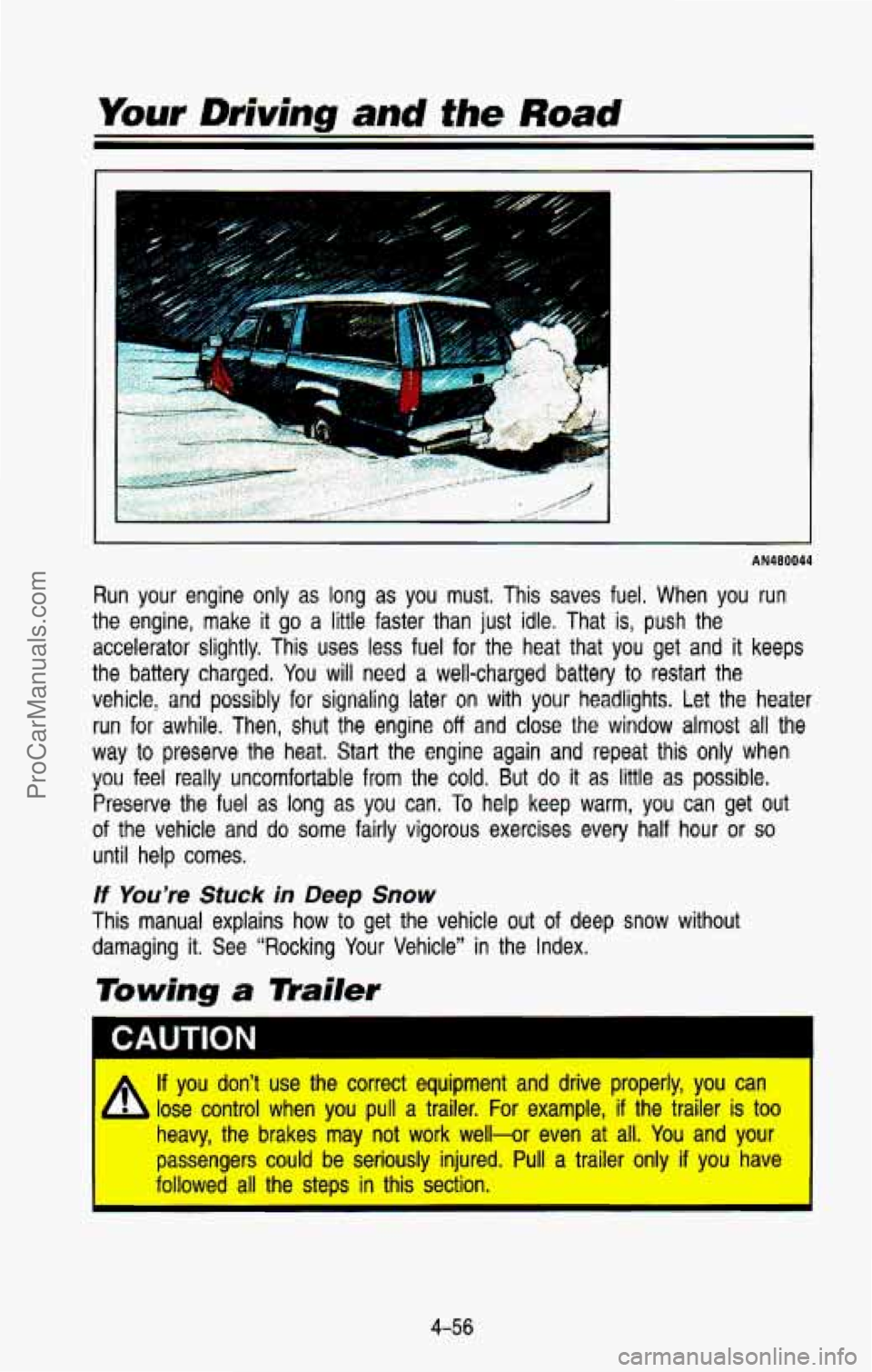
Your Driving and the Road
AN480044
Run your engine only as long as you must. This saves fuel. When you run
the engine, make
it go a little faster than just idle. That is, push the
accelerator slightly. This uses
less fuel for the heat that you get and it keeps
the battery charged.
You will need a well-charged battery to restart the
vehicle, and possibly
for signaling later on with your headlights. Let the heater
run for awhile. Then,
shut the engine off and close the window almost all the
way to preserve the heat. Start the engine again and repeat this only when
you feel really uncomfortable from the cold. But do it as little as possible.
Preserve the fuel as long as you can. To help keep warm, you can get out
of the vehicle and do some fairly vigorous exercises every half hour or so
until help comes.
If You’re Stuck in Deep Snow
This manual explains how to get the vehicle out of deep snow without
damaging it. See “Rocking Your Vehicle” in the Index.
Towing a mailer
I A If you don’t use the correct equipment and drive properly, you can
lose control when
you pull a trailer. For example, if the trailer is too
heavy, the brakes may not work well-or even at all. You and your
passengers could be seriously injured. Pull a trailer only
if you have
followed all the steps in this section.
4-56
ProCarManuals.com
Page 224 of 386

I NOTICE
’
I advice in this section.
Wing a trailer improperly can damage your vehicle and result in costly
epairs not covered by your warranty. To pull a trailer correctly, follow the
Every vehicle is ready for some trailer towing,
If it was built with trailering
options, as many are, it’s ready for heavier trailers. But \
trailering is different
than just driving your vehicle by itself. Trailering means changes in handling,
durability, and fuel economy. Successful, safe trailering takes \
correct equipment, and it has to be used properly.
That’s the reason for this section. In
it are many time-tested, important
trailering tips and safety rules. Many of these are important for your safety
and that of your passengers,
So please read this section carefully before you
pull a trailer.
If You Do Decide To Pull A Trailer
If you do, here are some important points.
e
e
There are many different laws having to do with trailering. Make sure
your rig
will be legal, not only where you live but also where you’ll be\
driving.
A good source for this information can be state or provincial
police.
Consider using sway control with a utility model
if your trailer will weigh
3,000 pounds (1361 kg) or less, or with a wagon model if your trailer
will weigh
4,000 pounds (1800 kg) or less. You should always use sway
control with a utility model
if your trailer will weigh more than 3,000
pounds (1 361 kg), or with a wagon model if your trailer will weigh more
than
4,000 pounds (1800 kg). You can ask a hitch dealer about sway
controls.
Don’t tow a trailer at all during the first
500 miles (800 km) your new
vehicle is driven. Your engine, axle, or other parts could be damaged.
Then, during the first
500 miles (800 km) that you tow a trailer, don’t
drive over
50 mph (80 kmlh) and don’t make starts at full throttle. That
will help your engine and other parts
of your vehicle wear in at the
heavier loads.
4-57
ProCarManuals.com
Page 227 of 386

Your Driving and 0% Road
Will you have to make any holes in the body of your vehicle when you
install a trailer hitch?
If you do, then be sure to seal the holes later
when you remove the hitch.
If you don’t seal them, deadly carbon
monoxide
(CO) from your exhaust can get into your vehicle (see “Carbon
Monoxide” in the Index). Dirt and water can, too.
Safety Chains
You should always attach chains between your vehicle and your trail\
er. Cross
the safety chains under the tongue of the trailer
so that the tongue will not
drop to the road
if it becomes separated from the hitch. Instructions about
safety chains may be provided by the trailer manufacturer. Follow the
manufacturer’s recommendation
for attaching safety chains. Always leave just
enough slack
so you can turn with your rig. And, never allow safety chains to
drag on the ground.
Trailer Brakes
If your trailer weighs more than 1,000 pounds (450 kg) loaded, then it needs
its own brakes-and they must be adequate. Be sure
to read and follow the
instructions for the trailer brakes
so you’ll be able to install, adjust and
maintain them properly.
Don’t tap into your vehicle’s brake system if the trailer’s brake system will use
more than
0.02 cubic inch (0.3 cc) of fluid from your vehicles master cylinder.
If it does, both braking systems won’t work well. You could even lose your
brakes.
Will the trailer brake parts take 3,000 psi (20 650 kPa) of pressure? If
not, the trailer brake system must not be used with your vehi\
cle.
If everything checks out this far, then make the brake fluid tap at the
port on the master cylinder that sends fluid
to the rear brakes. But don’t
use copper tubing for this.
If you do, it will bend and finally break off.
Use steel brake tubing.
Driving with a Trailer
Towing a trailer requires a certain amount of experience. Before setting out
for the open road, you’ll want
to get to know your rig. Acquaint yourself with
the feel of handling and braking with the added weight of the trailer. And
always keep in mind that the vehicle you are driving is now a good deal
longer and not nearly
so responsive as your vehicle is by itself.
Before you start, check the trailer hitch and platform, safety \
chains, electrical
connector, lights, tires and mirror adjustment.
If the trailer has electric brakes,
start your vehicle and trailer moving and then apply the trail\
er brake controller
by hand to be sure the brakes are working. This lets vou check your
electrical connection at the same time.
4-60
ProCarManuals.com
Page 228 of 386
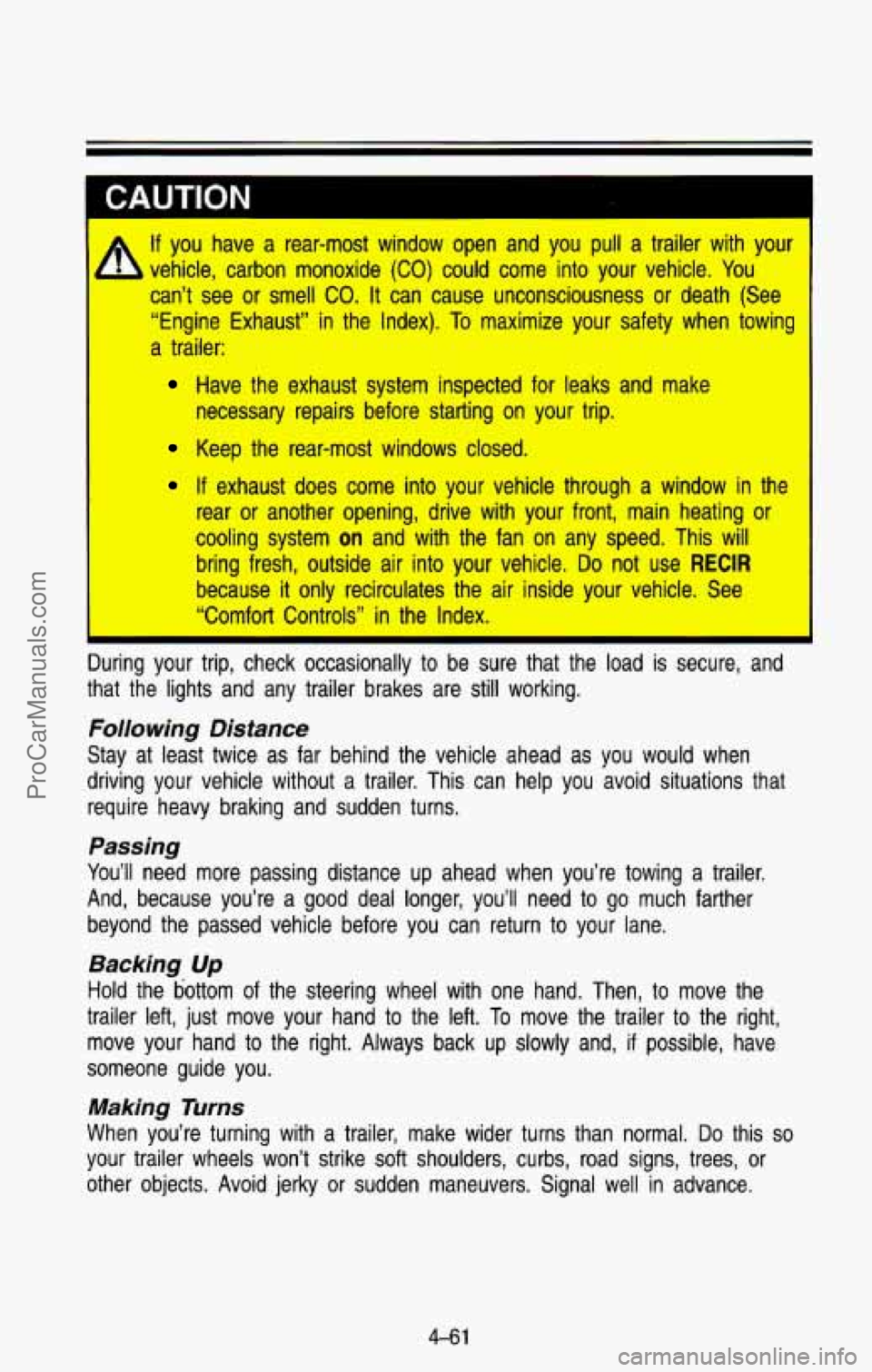
I
If you have a rear-most window open and you pull a trailer with \
your
can’t see or smell
CO. It can cause unconsciousness or death (See
“Engine Exhaust” in the Index).
To maximize your safety when towing
a trailer:
- vehicle, carbon monoxide (CO) could come into your vehicle. You
Have the exhaust system inspected for leaks and make
Keep the rear-most windows closed.
If exhaust does come into your vehicle through a window in the
rear or another opening, drive with your front, main heating or
cooling system
on and with the fan on any speed. This will
bring fresh, outside air into your vehicle.
Do not use RECIR
because it only recirculates the air inside your vehicle. See
“Comfort Controls” in the Index.
necessary repairs before starting on your trip.
During your trip, check occasionally to be sure that the load is secure, and
that the lights and any trailer brakes are still working.
Following Distance
Stay at least twice as far behind the vehicle ahead as you would when
driving your vehicle without a trailer. This can help you avoid situations that
require heavy braking and sudden turns.
Passing
You’ll need more passing distance up ahead when you’re towing a tr\
ailer.
And, because you’re
a good deal longer, you’ll need to go much farther
beyond the passed vehicle before you can return to your lane.
Backing Up
Hold the bottom of the steering wheel with one hand. Then, to move the
trailer left, just move your hand to the left.
To move the trailer to the right,
move your hand to the right. Always back up slowly and,
if possible, have
someone guide you.
Making Turns
When you’re turning with a trailer, make wider turns than n\
ormal. Do this so
your trailer wheels won’t strike soft shoulders, curbs, road signs, trees, or
other objects. Avoid jerky or sudden maneuvers. Signal well in advance.
4-61
ProCarManuals.com
Page 229 of 386
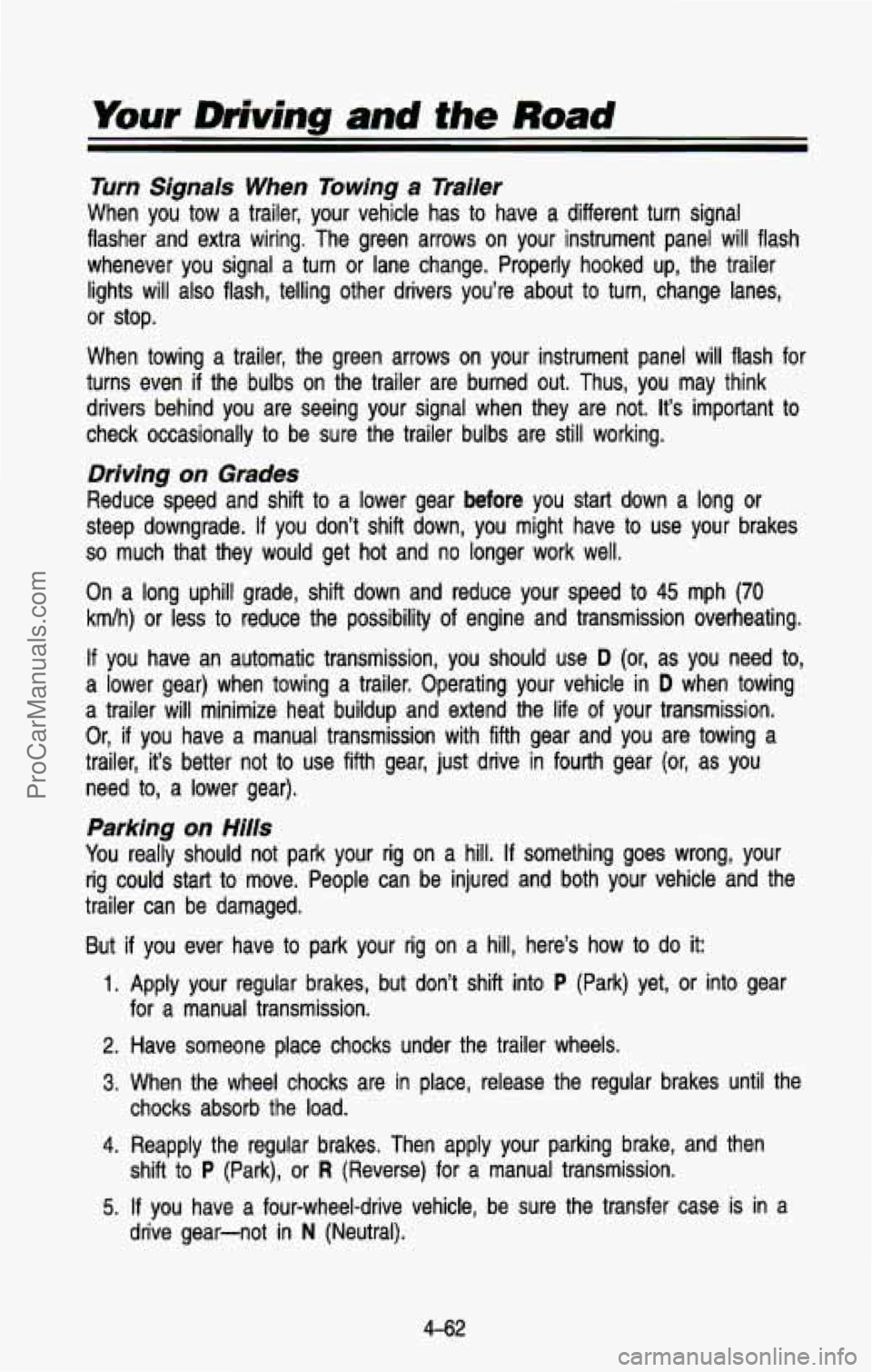
Your Driving and the Road
Turn Signals When Towing a Trailer
When you tow a trailer, your vehicle has to have a different turn signal
flasher and extra wiring. The green arrows on your instrument \
panel will flash
whenever you signal a turn
or lane change. Properly hooked up, the trailer
lights will also flash, telling other drivers you’re about
to turn, change lanes,
or stop.
When towing a trailer, the green arrows on your instrument pan\
el will flash for
turns even
if the bulbs on the trailer are burned out. Thus, you may think \
drivers behind you are seeing your signal when they are not.
It’s important to
check occasionally to be sure the trailer bulbs are still working.
Driving on Grades
Reduce speed and shift to a lower gear before you start down a long or
steep downgrade. If you don’t shift down, you might have to use your brakes
so much that they would get hot and no longer work well.
On
a long uphill grade, shift down and reduce your speed to 45 mph (70
kmlh) or less to reduce the possibility of engine and transmission overheating.
If you have an automatic transmission, you should use D (or, as you need to,
a lower gear) when towing a trailer. Operating your vehicle in D when towing
a trailer will minimize heat buildup and extend the
life of your transmission.
Or,
if you have a manual transmission with fifth gear and you are to\
wing a
trailer, it’s better not
to use fifth gear, just drive in fourth gear (or, as you
need to, a lower gear).
Parking on Hilk
You really should not park your rig on a hill. If something goes wrong, your
rig could start
to move. People can be injured and both your vehicle and the
trailer can be damaged.
But
if you ever have to park your rig on a hill, here’s how to do it:
1. Apply your regular brakes, but don’t shift into P (Park) yet, or into gear
for a manual transmission.
2. Have someone place chocks under the trailer wheels.
3, When the wheel chocks are in place, release the regular brakes\
until the
4. Reapply the regular brakes. Then apply your parking brake, and \
then
chocks absorb the load.
shift
to P (Park), or R (Reverse) for a manual transmission.
5. If you have a four-wheel-drive vehicle, be sure the transfer case \
is in
a
drive gear-not in
N (Neutral).
4-62
ProCarManuals.com
Page 230 of 386
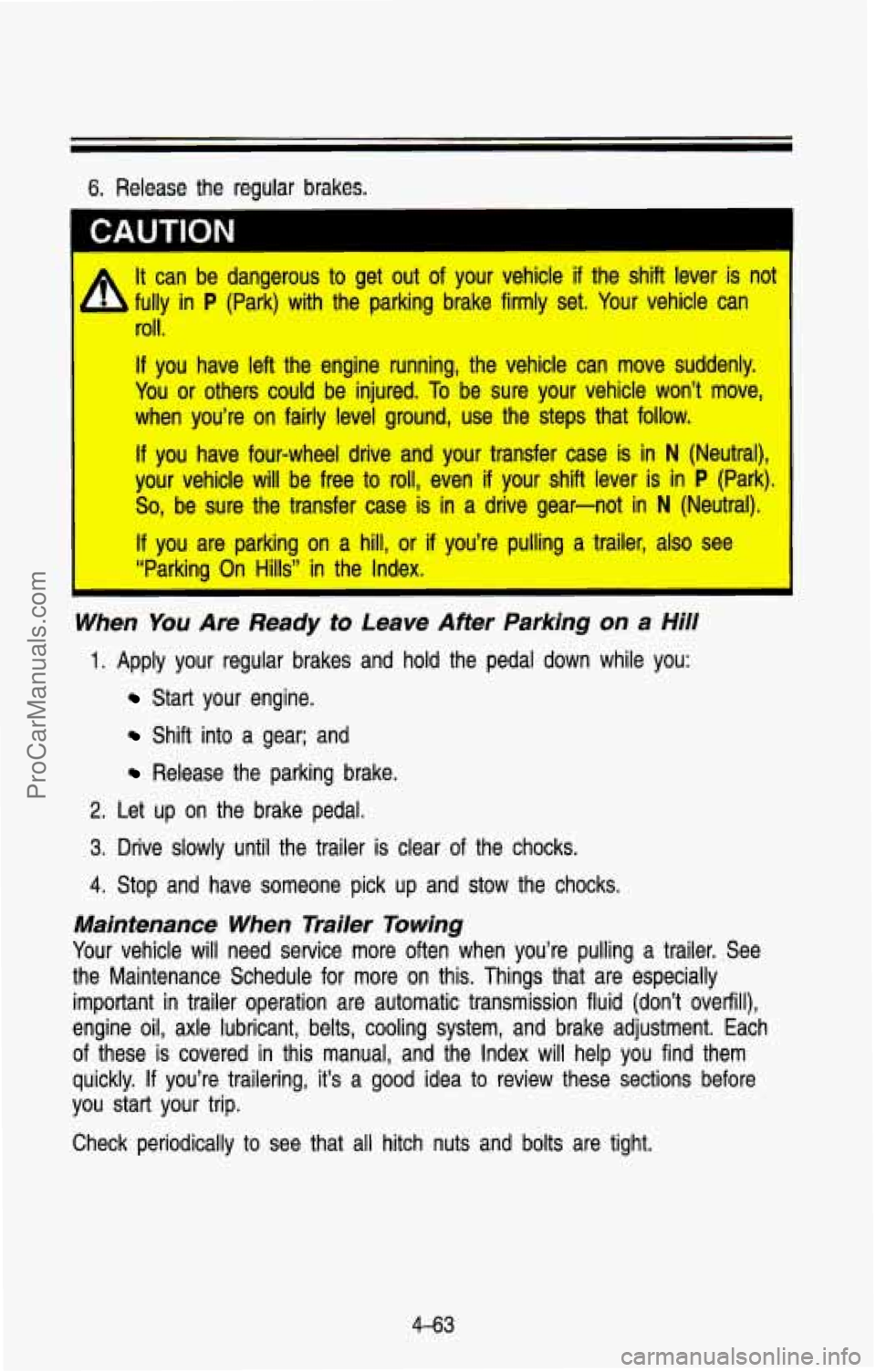
. .
6. Release the regular brakes.
CAUTION
It can be dangerous to get out of your vehicle if the shift lever is no
fully in
P (Park) wi-. the parking brake firmly set. Your vehicle can
roll.
If you have left the engine running, the vehicle can move suddenl\
y.
You or others could be injured.
To be sure your vehicle won’t move,
when you’re on fairly level ground, use the steps that foll\
ow.
If you have four-wheel drive and your transfer case is in N (Neutral),
your vehicle will be free to
roll, even if your shift lever is in P (Park)
So, be sure the transfer case is in a drive gear-not in N (Neutral).
If you are parking on a hill, or if you’re pulling a trailer, also see
I “Parking On Hills” in the Index. I
When You Are Ready to Leave After Parking on a Hill
1. Apply your regular brakes and hold the pedal down while you:
Start your engine.
Shift into a gear; and
Release the parking brake.
2. Let up on the brake pedal.
3. Drive slowly until the trailer is clear of the chocks.
4. Stop and have someone pick up and stow the chocks.
Maintenance When Trailer Towing
Your vehicle will need service more often when you’re pulling a \
trailer. .See
the Maintenance Schedule for more on this. Things that are especially
important in trailer operation are automatic transmission fluid (don’t overfill),
engine oil, axle lubricant, belts, cooling system, and brake ad\
justment. Each
of these is covered in this manual, and the Index will help you find them
quickly.
If you’re trailering, it’s a good idea to review these sections before
you start your trip.
Check periodically to see that all hitch nuts and bolts are tight.
4-63
ProCarManuals.com